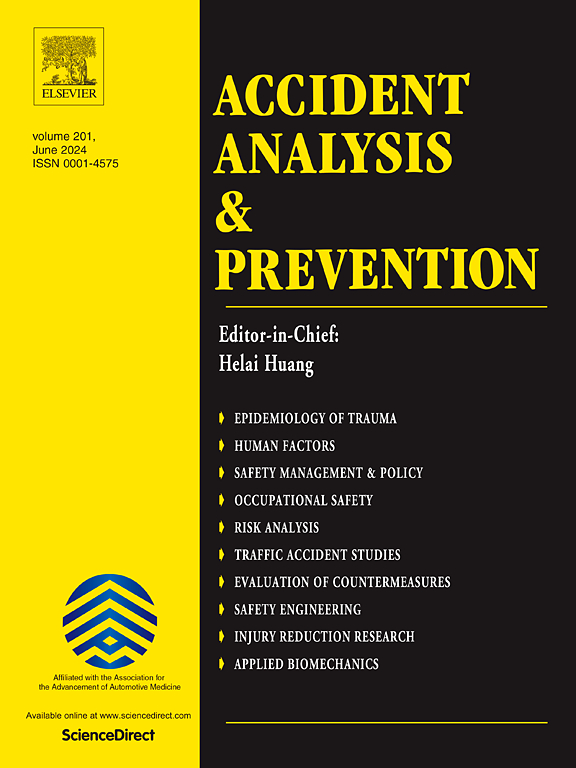2019冠状病毒病大流行期间安全状态的时间变化:来自隐藏半马尔可夫模型的见解。
IF 5.7
1区 工程技术
Q1 ERGONOMICS
引用次数: 0
摘要
新冠肺炎疫情严重影响了交通安全,在封锁初期,危险驾驶行为有所增加,导致严重撞车事故的可能性更高。然而,关于大流行后对驾驶行为和安全影响的研究有限。本研究通过分析弗吉尼亚州的公开数据来研究2016年至2024年安全州的变化,涵盖大流行之前、期间和之后的时期,从而解决了这一差距。利用结构方程模型(SEM)测量代表攻击性和不注意驾驶行为的潜在变量,并模拟其对碰撞严重程度的影响。此外,应用隐半马尔可夫模型(HSMMs)来推断与这些危险驾驶行为和严重碰撞比例相关的安全状态的变化。HSMM模型的优势在于能够从随机噪声中区分有意义的模式变化。与隐马尔可夫模型(hmm)相比,隐马尔可夫模型通过适应任意状态持续时间分布提供了更大的灵活性,有助于更好的模型性能和更可靠的推断。有四个隐藏状态的hsmm被用来揭示弗吉尼亚州八年分析期间安全状态的变化。结果表明,2016 - 2019年,与危险驾驶行为和严重碰撞比例相关的安全状态在大流行前处于较低风险水平,在2020年大流行期间升级为最高风险水平,并在2021年、2022年和2023年保持较高风险水平。到2024年,安全状态已恢复到与大流行前时期相似的较低风险水平。在安全州也发现了季节性模式,在接近假日季节的冬季,风险水平较低或最低。本文章由计算机程序翻译,如有差异,请以英文原文为准。
Temporal shifts in safety states through the COVID-19 pandemic: Insights from hidden semi-Markov models
The COVID-19 pandemic significantly impacted transportation safety, with an increase in risky driving behaviors observed during the initial lockdown period, leading to a higher likelihood of severe crashes. However, there is limited research on the post-pandemic effects on driving behaviors and safety. This study addresses this gap by analyzing open data from the state of Virginia to examine shifts in safety states from 2016 to 2024, covering the pre-, during-, and post-pandemic periods. Structural equation modeling (SEM) was utilized to measure latent variables representing aggressive and inattentive driving behaviors and to model their impacts on crash severity. Additionally, hidden semi-Markov models (HSMMs) were applied to infer shifts in safety states associated with these risky driving behaviors and the proportion of severe crashes. The strength of HSMM models lies in the ability to distinguish meaningful pattern changes from random noise. Compared with hidden Markov models (HMMs), HSMMs provide greater flexibility by accommodating arbitrary state duration distributions, contributing to better model performance and more reliable inferences. The HSMMs with four hidden states were utilized to reveal shifts in safety states over the eight-year analysis period in Virginia. Results suggested that safety states related to risky driving behaviors and the proportion of severe crashes were at lower-risk levels pre-pandemic from 2016 to 2019, then escalated to the highest-risk levels during the pandemic in 2020 and remained at higher-risk levels in 2021, 2022 and 2023. By 2024, safety states have returned to lower-risk levels similar to those inferred in the pre-pandemic period. A seasonal pattern was also identified in safety states, with lower-or-lowest-risk levels occurring in winter near the holiday season.
求助全文
通过发布文献求助,成功后即可免费获取论文全文。
去求助
来源期刊

Accident; analysis and prevention
Multiple-
CiteScore
11.90
自引率
16.90%
发文量
264
审稿时长
48 days
期刊介绍:
Accident Analysis & Prevention provides wide coverage of the general areas relating to accidental injury and damage, including the pre-injury and immediate post-injury phases. Published papers deal with medical, legal, economic, educational, behavioral, theoretical or empirical aspects of transportation accidents, as well as with accidents at other sites. Selected topics within the scope of the Journal may include: studies of human, environmental and vehicular factors influencing the occurrence, type and severity of accidents and injury; the design, implementation and evaluation of countermeasures; biomechanics of impact and human tolerance limits to injury; modelling and statistical analysis of accident data; policy, planning and decision-making in safety.
 求助内容:
求助内容: 应助结果提醒方式:
应助结果提醒方式:


